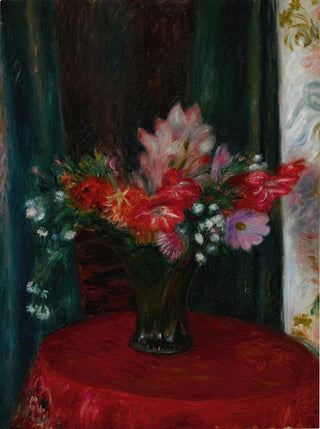Art print | Bouquet sur nappe rouge - William James Glackens


View from behind

Frame (optional)
Bouquet on red tablecloth - William James Glackens – Captivating introduction
In the world of art, some works manage to capture the essence of a moment, evoke deep emotions, and transport the viewer into a sensory universe. "Bouquet on red tablecloth" by William James Glackens is one of these creations. This canvas, vibrant with colors and life, evokes the fleeting beauty of flowers and the intimacy of a shared moment around a table. The composition, both simple and refined, invites appreciation of the delicacy of details while celebrating the richness of the chromatic palette. Contemplating this piece, one almost feels the scent of the flowers, and is transported into a warm atmosphere, conducive to reflection and daydreaming.
Style and uniqueness of the work
Glackens' style is characterized by an impressionist approach that harmoniously blends with a touch of realism. In "Bouquet on red tablecloth," the artist plays with light and shadows to bring his subjects to life. The flowers, bursting with color, seem to vibrate under the viewer's gaze, while the red tablecloth, rich and textured, creates a striking contrast. This choice of colors is not accidental; it evokes passion and warmth, while providing a backdrop that highlights the natural beauty of the flowers. Glackens manages to capture not only the appearance of objects but also their essence, their vitality. Each brushstroke tells a story, and each color evokes an emotion, transforming a simple still life into a celebration of life.
The artist and his influence
William James Glackens, an emblematic figure of the American artist movement of the early 20th century, established himself through his unique style and artistic vision. Evolving within the Ashcan School group, he sought to depict everyday life with a new sensitivity. His work is marked by a desire to capture the present moment, to celebrate the simple yet precious moments of existence. Glackens successfully combined European influences with American traditions, thus creating a bridge between two artistic worlds. His innovative approach has inspired many contemporary artists and has contributed to redé

Matte finish

View from behind

Frame (optional)
Bouquet on red tablecloth - William James Glackens – Captivating introduction
In the world of art, some works manage to capture the essence of a moment, evoke deep emotions, and transport the viewer into a sensory universe. "Bouquet on red tablecloth" by William James Glackens is one of these creations. This canvas, vibrant with colors and life, evokes the fleeting beauty of flowers and the intimacy of a shared moment around a table. The composition, both simple and refined, invites appreciation of the delicacy of details while celebrating the richness of the chromatic palette. Contemplating this piece, one almost feels the scent of the flowers, and is transported into a warm atmosphere, conducive to reflection and daydreaming.
Style and uniqueness of the work
Glackens' style is characterized by an impressionist approach that harmoniously blends with a touch of realism. In "Bouquet on red tablecloth," the artist plays with light and shadows to bring his subjects to life. The flowers, bursting with color, seem to vibrate under the viewer's gaze, while the red tablecloth, rich and textured, creates a striking contrast. This choice of colors is not accidental; it evokes passion and warmth, while providing a backdrop that highlights the natural beauty of the flowers. Glackens manages to capture not only the appearance of objects but also their essence, their vitality. Each brushstroke tells a story, and each color evokes an emotion, transforming a simple still life into a celebration of life.
The artist and his influence
William James Glackens, an emblematic figure of the American artist movement of the early 20th century, established himself through his unique style and artistic vision. Evolving within the Ashcan School group, he sought to depict everyday life with a new sensitivity. His work is marked by a desire to capture the present moment, to celebrate the simple yet precious moments of existence. Glackens successfully combined European influences with American traditions, thus creating a bridge between two artistic worlds. His innovative approach has inspired many contemporary artists and has contributed to redé






